Me: Having our last servings of gumbo.
Steve: Why? Was there some okra catastrophe?
Me: Not our last ever, just the last of this batch of soup. But now I’m worried about the okrapocalypse.

Me: Having our last servings of gumbo.
Steve: Why? Was there some okra catastrophe?
Me: Not our last ever, just the last of this batch of soup. But now I’m worried about the okrapocalypse.
Bed of spring greens and spinach, carrot shreds, red onion, celery, just a few bites of apple, strip of bacon, smoked salmon, smoked gouda, generous handful of walnuts. Dressed with @PrimalKitchenCo Green Goddess dressing: All the protein and healthy fats.
I do not understand the logic of “[Brand name] fake meat is awesome. There’s no reason to eat real sausage.”
We’ve got 50 years of evidence that hyper-palatable industrially produced food-like substances are bad for you, but people somehow think that hyper-palatable industrially produced meat-like substances are going to be different?
Some years back, after I’d finally made some real progress at losing weight and getting in shape, I was thinking of writing a post about it, when an on-line acquaintance posted a stern note to the effect that she didn’t want to see any “weight-loss success stories” from anyone who hadn’t kept the weight off for five years.
It’s a reasonable perspective. Almost any weight loss program will work for six months. Almost nobody who undertakes such a program manages to get down to a normal weight and maintain that weight for five years.
Despite the aforementioned reasonableness, I was somewhat put off by her attitude. Who was she to tell me when and how I could tell my own story? (To be fair, she wasn’t telling me I couldn’t tell my story, just that she didn’t want to see it.)
That feeling of being just a tiny bit stifled made the whole thing stick in my mind, such that I’ve kept track: February 14th, 2015 was when my BMI dropped from 25 (overweight) to 24.9 (normal weight). It has now been in the “normal weight” range for five years.
I didn’t stop there. I continued losing weight for almost two more years, until in December 2016 I decided that I didn’t want to get any smaller. At that point I started targeting a stable weight (145 lbs, which gives me a BMI right at the midpoint of the “normal weight” range). I’ve achieved my target pretty well, keeping my weight to within plus-or-minus about 3 pounds of my target.
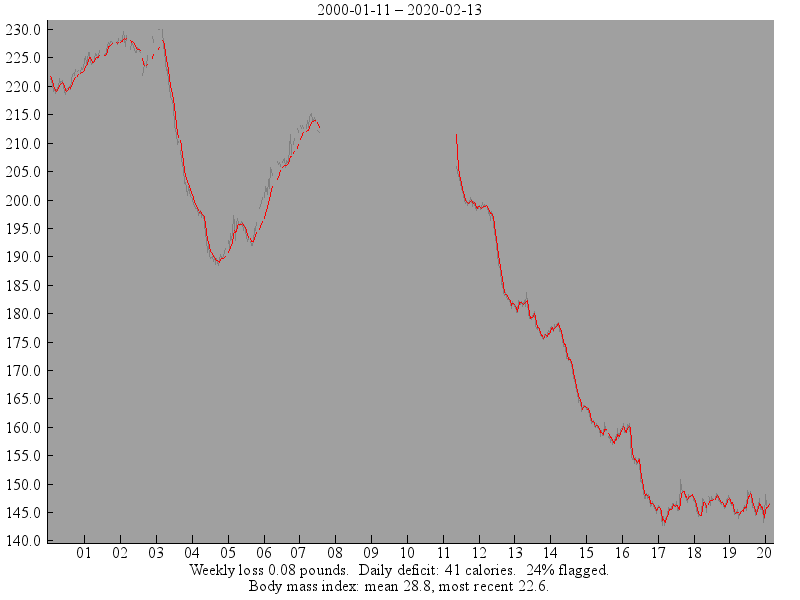
I wish I had something useful to say about how to lose weight, but I really don’t.
I lost the first fifty pounds the long, slow, hard way—eating less (portion control) and moving more. Because it was hard—I was hungry all the time—I knew that even a slight misstep could easily see me gaining back back all that weight. At that point I did an experiment with low-carb eating, to see if it would address some health issues unrelated to my weight, and quickly peeled off another 15 pounds.
Since then I’ve been eating what I call a “carb-aware whole-foods diet,” meaning that my main focus is on eating food (and refraining from eating industrially produced food-like substances), but purposefully keeping my carbs down in the 100–125 grams per day range, and taking my carbs down lower if my weight gets up above where I want it.
Because eating low-carb worked well for me, I’m modestly inclined to be a booster of the diet, but only modestly. Who am I to say that just because it worked for me it would work for anyone else?
Besides eating actual food and watching my carbs, anybody who reads my blog knows that I spend a lot of time moving. Just click on the “exercise” tag or the Fitness category to see post after post talking about my efforts to get enough exercise (in the old days), and see how they gradually changed into my efforts to keep moving throughout the day. It’s common knowledge that you can’t exercise your way out of a bad diet, but I think it’s also true that moving throughout the day is critical to achieving and maintaining good health.
Might reversing this be the solution to the raccoon menace?
Urbanites abandoned small game like raccoon, which was laced with unfavorable racial and class stigmas, in favor of cheap pork, chicken, and beef.
Source: Why President Coolidge Never Ate His Thanksgiving Raccoon
Almost two years ago I made some lard. It lasted pretty well (I don’t use much), but I noticed recently that it was almost gone. So I requested a couple of pounds of pork fat from the meat lab, got 2.4 lbs, rendered it yesterday, and now I have almost a quart of fresh, milky white, unbleached lard.

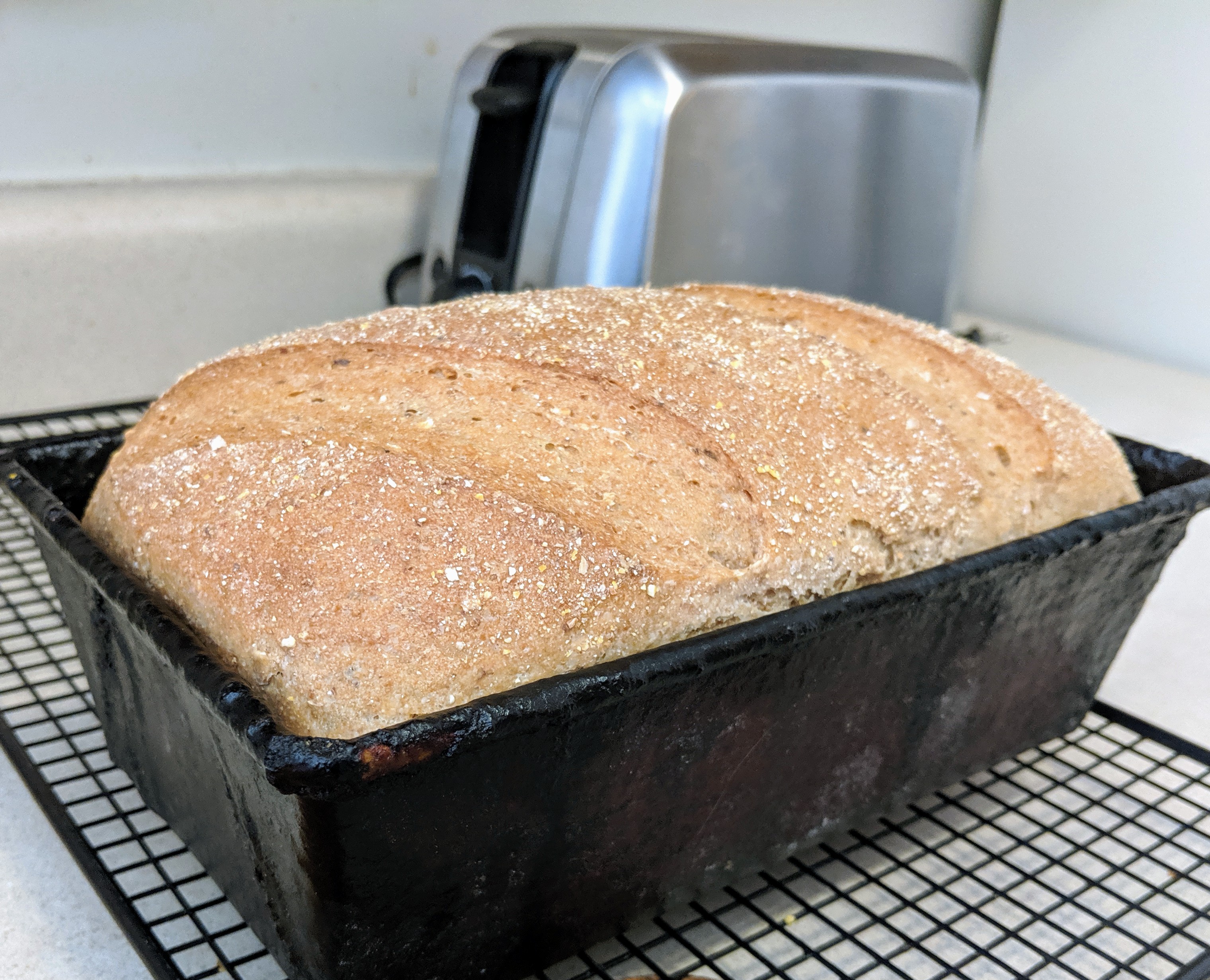
Since drinking some scotch fermented with a wild yeast found on some barley, I’ve been meaning to feed Bubbles (our sourdough starter) some barley flour, in the hopes of finding her some new playmates. Today I did.
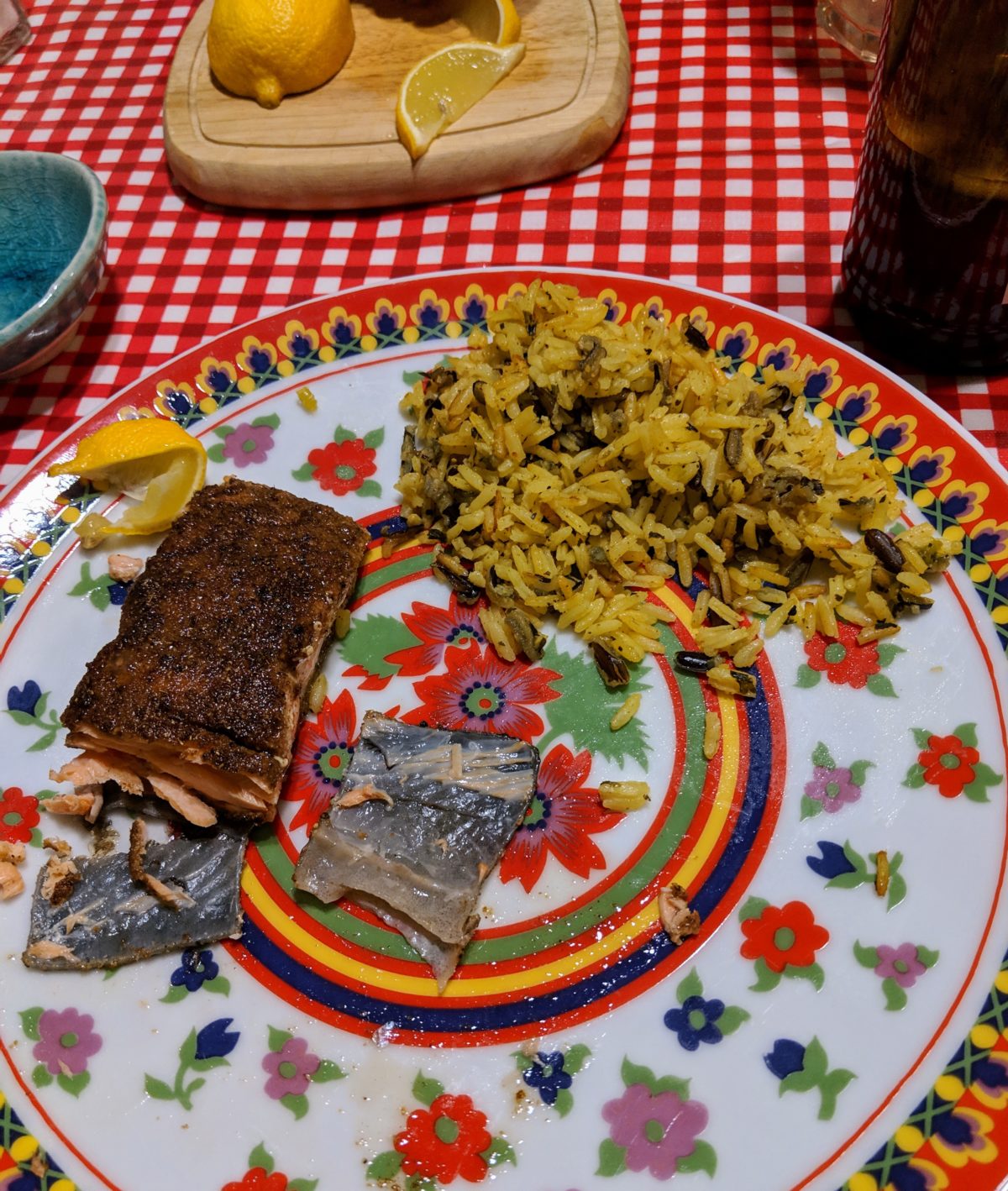
Shortly before the solstice we happened upon a woman at the farmers market selling CSA-style shares in the output a collective of small Alaskan fishing boats, and bought their package that will give us salmon (and other Alaskan fish) in May, June, July, and August.
Part of the deal was getting their “holiday gift box” for free. That box, with two kinds of salmon, a generous amount of cod, some spice mixtures, and some recipes, arrived (frozen and packed with dry ice) in time for a solstice feast, but we had our various feasts for the solstice period already planned, so we initially just put our salmon in the freezer.
Now that our planned solstice and related holiday feasting is done, yesterday I decided to go ahead and cook one of the big pieces of salmon from our holiday box.
More or less at random, I pulled a piece of coho salmon from the freezer. (I wanted salmon, since that’s what the whole thing is all about. We’ll eat the cod in due course.) The holiday box came with some spice mixtures, but today I used a recipe from Mark Bittman called 4-spice salmon that Jackie found a while ago.
It turned out really well. I served it with some Uncle Phil’s long-grain and wild rice (easy to make, as long as you remember to start the wild rice an hour before time to start the long-grain rice).
I neglected to take a picture until I was half done eating, but you can still see how it came out in the photo above. We actually only ate 4/5ths of what I cooked. We saved the biggest 5th to go on a chef’s salad today.
If you really like salmon, and can afford to invest a bit up-front to get a steady supply, and you live in the Midwest, you might want to seriously consider Sitka Salmon Shares. We’ve only had one meal so far, but it was yummy. I’m really looking forward to substantially upping the amount of wild-caught salmon in our diet this coming year.
I have been amused to see “bone broth” trending of late, as I can’t remember the last time our household cooked anything with a bone in it and then failed to make broth out of it. It has been decades, at least.
(If something just has a bit of bone, like a serving of ribs or a bone-in steak or chop, we put the bone in the freezer and then throw it in with the next carcass we boil down for broth.)
Still, with broth showing up so much in the media lately, I keep wanting more of it (due merely to the power of suggestion), and although we eat plenty of meat, our roasting of carcasses hasn’t quite kept up with our broth needs.
So Thursday I swung by the butcher and got something over 4 pounds of frozen chicken necks. (They freeze them in a big trough-shaped container from which they can saw off a block of about three inches high by 4 inches deep by as long as someone wants.)
I put the block in a roasting pan and put it in the oven at 325℉ until it started being possible to pull off individual necks. Then I turned it up to 400℉ so I could get a bit of browning of the skin and pick up some nice roasty flavor. Once I had the necks a little bit roasted, I divided them between two big soup pots, added a little cider vinegar, a roughly quartered onion, some celery tops, and water. Then I boiled them for 3 or 4 hours, which wasn’t as long as would be ideal, but thawing the big block had taken longer than I’d expected and it was getting on to bedtime. Yield: about 12 cups of broth.
The butcher also sells cow femurs to use for broth, but that’s crazy. The good stuff in broth comes at least as much from the associated connective tissue as it does from the bones themselves. What you want is something like a tail or a back or a neck—something with lots of cartilage, ligaments, and tendons along with the bones. Skin is nice too.
Today I used three cups of my fresh broth and three cups of frozen broth from a recent smoked chicken carcass to make some lentil soup (with red lentils and red carrots, but foolishly not red onions or red potatoes, even though I had some of each).
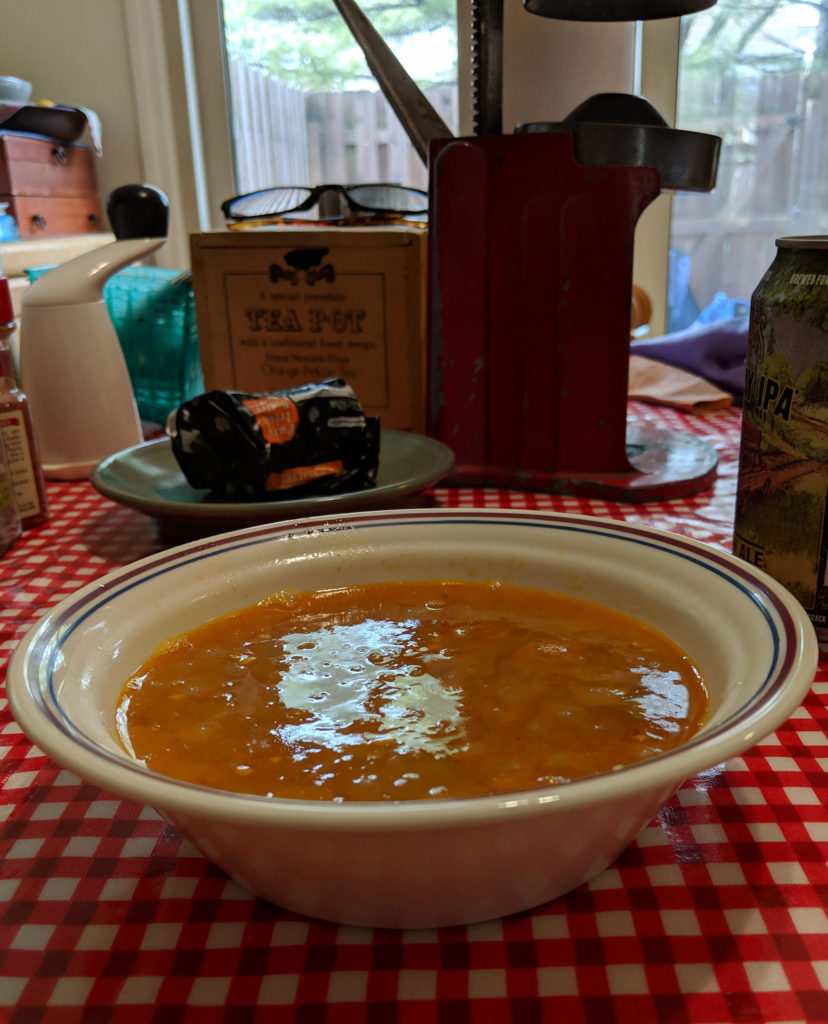
It came out a little neutral in flavor—it had some dried red pepper as well, but turned out not to be as spicy as I’d expected. I added extra salt and black pepper and vinegar at the table, and it was yummy. I figure slightly neutral will be great for leftovers, as we can mix up the spices however we want.
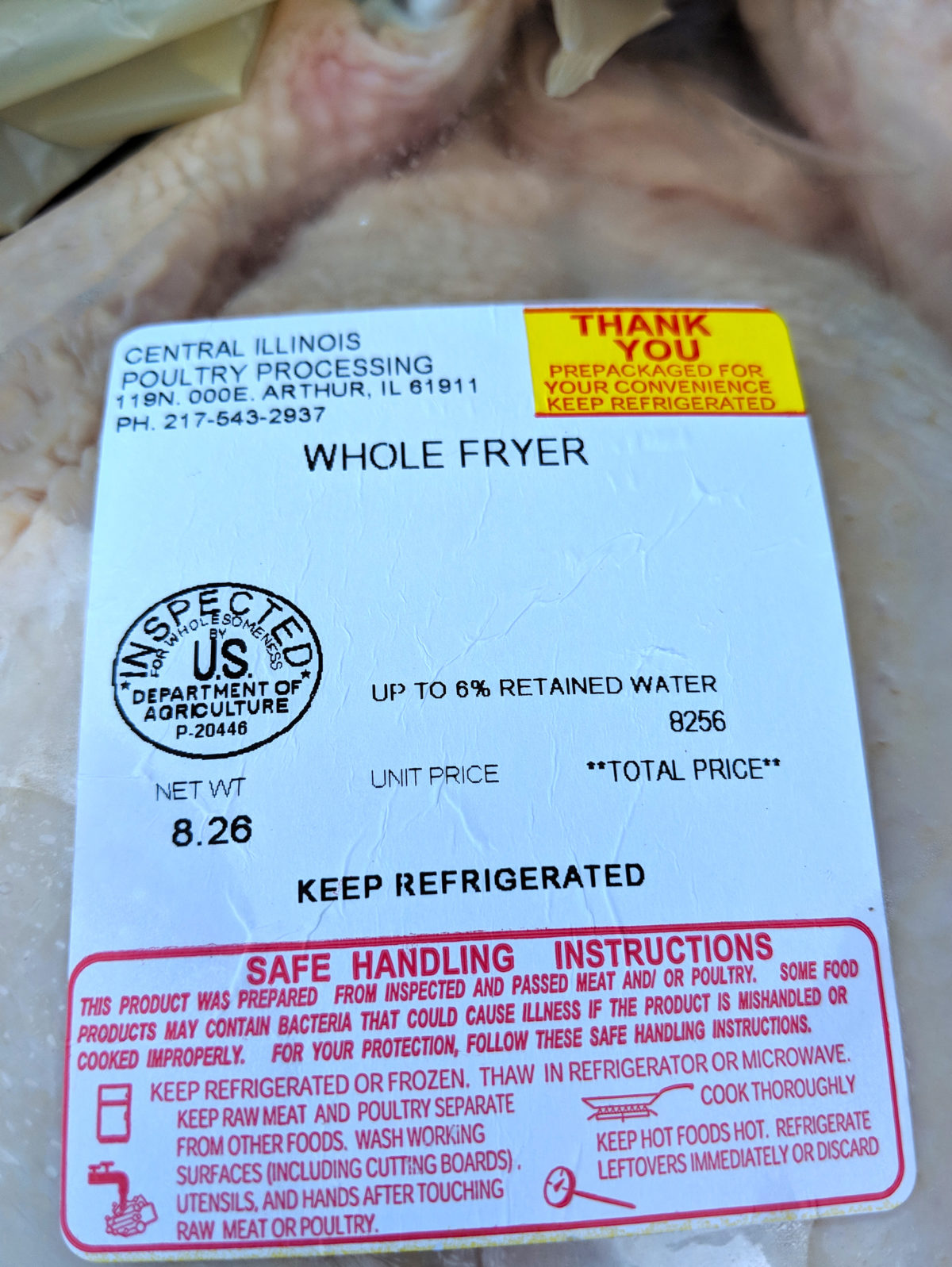
Jackie and I went to the University of Illinois Meat Sales Room, aka the Meat Lab, to buy eggs. On the way in, I noticed a sign on the window saying that they had fresh chickens available for $1.75/lb.
I had just been saying on twitter that, with USDA changing the rules to allow chicken to be shipped to China to be cut up into pieces and then shipped back to the U.S. and sold as “Product of USA” with no further inspection, it was perhaps time to just switch to only eating local chickens. These chickens, produced by the university’s agriculture department as part of their educational mission, certainly qualify—the Poultry Research Farm is only about 2 miles away from our house.
So, once we got in line with our eggs, I told the woman at the fresh case that I wanted one chicken. And I got one.
It weighs 8.26 lbs.
Basically, it’s the size of a small turkey.
I have never seen a chicken this size. It outweighs the next biggest chicken I’ve ever bought by a solid 50%.
Jackie has undertaken to cook this enormous chicken, which will no doubt provide leftovers for days.